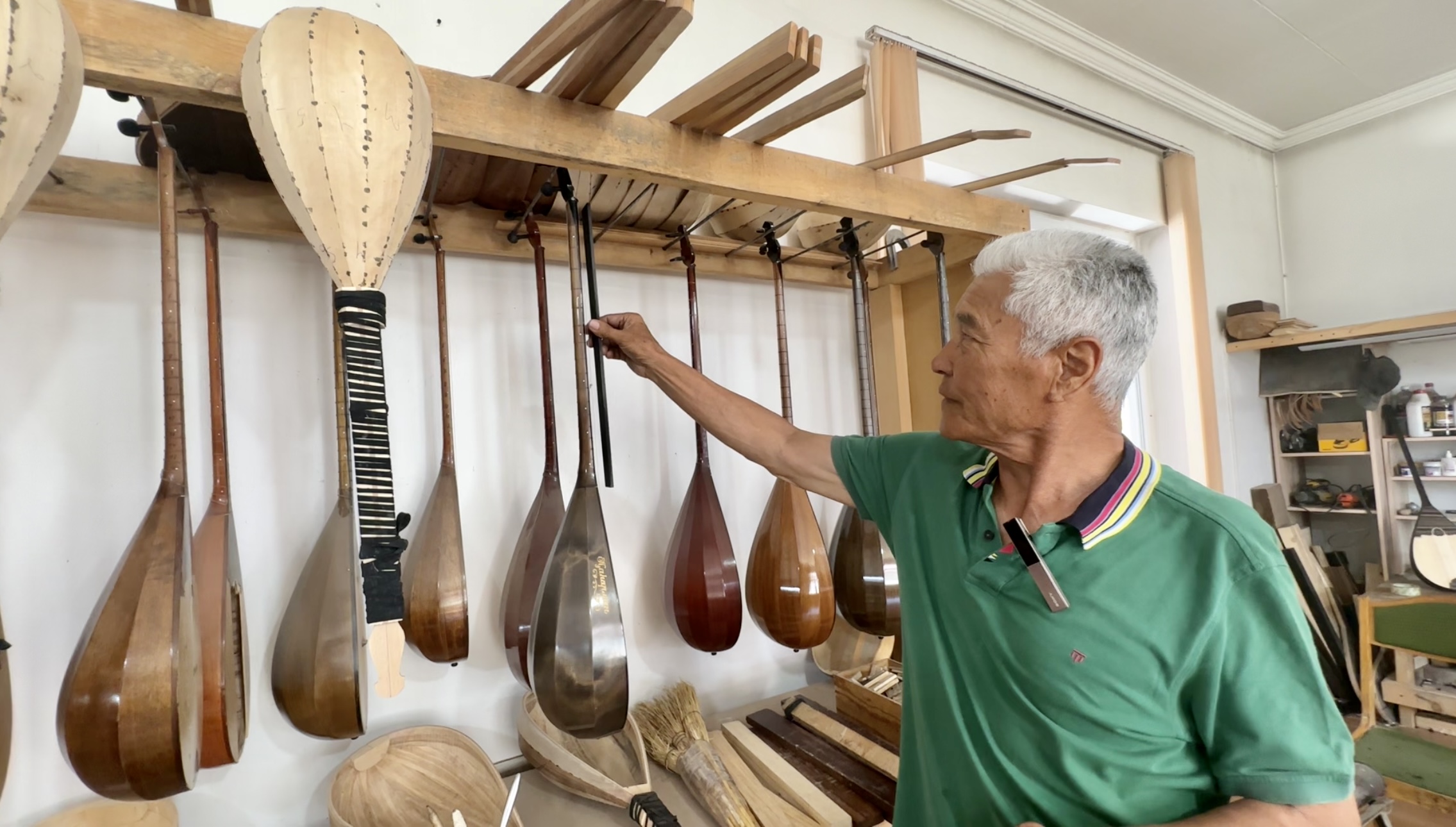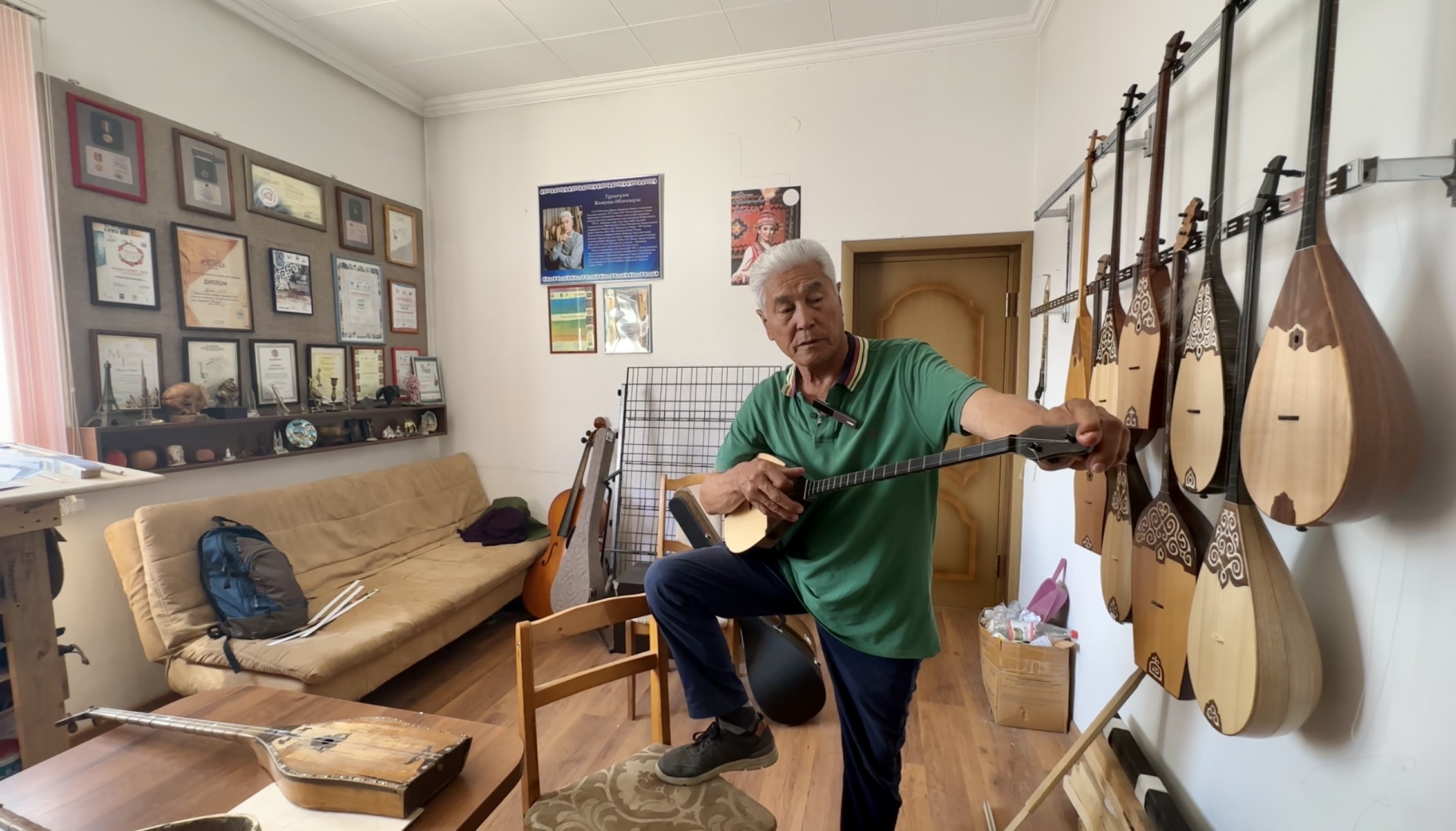ALMATY – Zholaushy Turdugulov is one of a handful of traditional dombra craftsmen who preserve the traditional craft of instrument-making and know how to skillfully bring the best sound out of dombra, a two-string Kazakh instrument that is deemed the soul of Kazakh culture.

Zholaushy Turdugulov has been making Kazakh dombras for over 50 years now. Photo credit: Aibarshyn Akhmetkali/The Astana Times
Dombra is essential to the heritage of the Kazakh people. Its unmistakable sound is almost synonymous with the Kazakh steppe itself. The dombra kui, which is a short solo composition performed on dombra, is known for its harmonious sounds, so much so that the United Nations Educational, Scientific and Cultural Organization (UNESCO) added it to its Intangible Cultural Heritage of Humanity list in 2014.
From hobby to profession
The skill of crafting an instrument is often passed down from a master to a student, but Turdugulov did not inherit the profession from the teachers. Instead, it became a skill he acquired himself. For him, it was a challenging journey of learning from everyone.

Photo credit: Aibarshyn Akhmetkali/The Astana Times
Turdugulov said he has been fond of wood-crafting since he was young, and that gradually transformed into instrument-making.
“The first time I was in the army there was a guy named Kozhakan. He taught me for the first time how to make a dombra because he saw I had a knack for wood and woodcutting. Those were the times in the army when I missed the dombra, so I proposed to him to show me how to make one. He showed me how to do it. That was my first lesson,” Turdugulov told The Astana Times correspondent, who went to his workshop in Almaty to see first-hand how the best-quality instruments are made using specially selected woods, not to mention the distinct beauty one could hear from an intrinsically made dombra.
After studying for a theater artist and set designer, Turdugulov ended up working in Almaty at a workshop. From that point on, his road to mastering the instrument craftsmanship began. Eventually, he turned his passion into a profession. Musicians from all over Kazakhstan visit him in search of the mellow, rich sound the dombra produces.

Musicians from all over Kazakhstan visit Turdugulov in search of the mellow, rich sound that his dombras produce. Photo credit: Aibarshyn Akhmetkali/The Astana Times
“It was not difficult for me to make the dombra because I knew the sound of the dombra and I knew how to play it myself. After a while, I outgrew everyone in the sphere of dombra-making,” said Turdugulov.
“There are some qualities given as human nature. For me, I was inclined towards this form of art,” he added.
He produced his first dombra in his 20s. “Now let me show you the first dombra I made,” said Turdugulov, taking an old but neat instrument out of his closet.
“I made it in the 1980s. It was carved from a solid piece of wood. At first, it was round, but at that time, I didn’t know well how to make a dombra, so it was uncomfortable. Later, I removed the round back and glued the plain one in its place. This dombra is made of red pine, with the head and neck completely carved out. Such types of dombras are common to the eastern part [of Kazakhstan],” he said.
Dombra making process
Making a quality-sounding dombra is no easy feat. Significant skill is required to put the dombra pieces together, which is learned slowly over the years.

Dombras at different stages of making: some are just getting assembled, others are drying out after being varnished. Photo credit: Aibarshyn Akhmetkali/The Astana Times
“The process begins with the preparation of materials, the cuts of the trees. The neck piece is craved separately, the main body piece separately, and the front piece is craved separately. For each piece, there is their own suitable tree. For example, the front part is mostly [made from] spruce and pine. But those are not used in the body piece. The tree choice for the body part should be an easily bendable tree,” he said.
According to Turdugulov, the craft of making dombras relies heavily on the choice and the quality of the wood used.
“In fact, 90% of the sound quality depends on the front wood. It is the front tree that speaks and gives the sound. It can be made from spruce and pine. Our ancestors also covered the front surface with juniper,” said Turdugulov.

Photo credit: Aibarshyn Akhmetkali/The Astana Times
The process continues with forming the wooden ribs of the body, gluing them, hand-cutting the neck pieces, and finally, putting all the pieces together and decorating the instrument. His students spend between one week to 15 days making two to three dombras.
“They don’t just make one dombra, they make two or three dombras in a row. Why is that? For example, one finishes building the body of one [dombra], puts it aside until it dries, and starts another one. He [or she] builds it and starts the third one, then the previous dombra is dry and ready for the next step of the process. Then you don’t lose time. One could finish three dombras in about fifteen days. Those who do it quickly will finish in ten days,” said Turdugulov.
One master handles the entire procedure from start to finish.
One of the key conditions Turdugulov has for making dombra is maintaining the quality of the instrument and the sound.
“Whether you do it for a month or half a year, do it well. Quality is paramount, be it in terms of sound, design, or built,” said Turdugulov.
What makes a good craftsperson?
For Turdugulov, dombra crafting is far more than just commerce. Here, he spells out what to expect from a good artisan. A person should be skilled in wood carving and love to work with the wood in order to make a good instrument.

90% of the sound quality depends on the front wood. “It is the front tree that speaks and gives the sound,” says Turdugulov. Photo credit: Aibarshyn Akhmetkali/The Astana Times
“First of all, a person should be talented. It is necessary to be a person who can do things and knows woodworking,” he said.
How good of a dombra player does one have to be to make a good instrument? “Very good,” answered Turdugulov. Dombra-makers need to know how to play them to make a quality instrument because one should distinguish a good one from the sound.
“Instruments rely on the hearing condition of the human ear. It is necessary to be able to distinguish sound, to be musically literate,” he said.
“Musical instruments are live things. You put your soul and body into it, you communicate with it, and only then you make it speak. The things created with all of your soul will become alive. The more you love it, the more it will respond,” added Turdugulov.

The master at work. Photo credit: Aibarshyn Akhmetkali/The Astana Times
Professional craftspeople can tell the wood’s qualities from its sound even before assembling it into an instrument.
“One should be able to recognize trees and sort them. You need to be able to distinguish how old a tree is. To understand the acoustic properties of the tree, you need to feel it. For example, you can know whether the wood is acoustic by hitting it. You need to feel in advance what kind of instrument it will become and what kind of sound it will make,” said Turdugulov.
Turdugulov has been training students for over 26 years. Many students have found their own paths in making dombra through his teachings.
“I consider myself lucky to be in this art and to have trained so many students. Naturally, if they increase in number, the competition will get tougher for me, but in that case, the craft will continue to advance,” said Turdugulov.
For Turdugulov, it is another step in his quest to return the dombra to its rightful place in the Kazakh culture, spreading awareness of its authenticity, techniques and traditions.
“We should not lose our traditional dombra and qylqobyz (Kazakh string instrument, resembling cello). It is our duty to restore those instruments that once were nearly forgotten,” he said.

